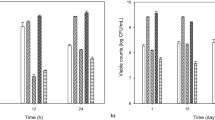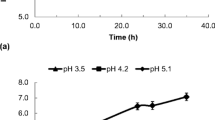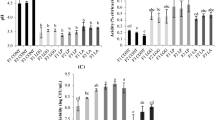Abstract
A probiotic strain Lactobacillus plantarum PCS26 was used to ferment Jerusalem artichoke juice. Growth kinetics of the bacterial strain was followed during juice fermentation both in flask and in laboratory fermentor. Jerusalem artichoke showed to be an excellent source of nutrients for L. plantarum PCS26 growth. The culture grew very well reaching more than 1010 cfu/ml in just 12 h. The pH changed from the initial 6.5 to 4.6 at the end of fermentation. The culture hydrolyzed fructooligosaccharides present in the Jerusalem artichoke juice, yielding fructose which was presumably consumed along with the malic acid as energy and carbon source. Lactic acid was the main metabolite produced in concentration of 4.6 g/L. Acetic and succinic acid were also identified. Sensory evaluation of the fermented Jerusalem artichoke juice and its mixtures with blueberry juice showed that the 50/50 % v/v mixture would be very well accepted by the consumers. Above 80 % of the panelists would buy this drink, and over 60 % were willing to pay more for it. Culture survivability in the fermented juices during storage at 4–7 °C was assayed by the Weibullian model. The product shelf-life was extended from 19.70 ± 0.50 days of pure Jerusalem artichoke juice to 35.7 ± 6.4 days of the mixture containing 30 % blueberry juice.






Similar content being viewed by others
References
Andersen AA, Greaves JE (1942) d-lactic acid fermentation of Jerusalem artichokes. Ind Eng Chem 34:1522–1526. doi:10.1021/ie50396a024
Axelsson L (1998) Lactic acid bacteria: classification and physiology. In: Selminen S, von Wright A (eds) Lactic acid bacteria: microbiological and functional aspects, 2nd edn. Marcel Dekker, New York, pp. 1–72
Bassit N, Boquien CY, Picque D, Corrieu G (1993) Effect of initial oxygen concentration on diacetyl and acetoin production by Lactococcus lactis subsp. lactis biovar diacetylactis. Appl Environ Microbiol 59:1893–1897
Betoret E, Betoret N, Arilla A, Bennár M, Barrera C, Codoñer P, Fito P (2012) No invasive methodology to produce a probiotic low humid apple snack with potential effect against Helicobacter pylori. J Food Eng 110:289–293. doi:10.1016/j.jfoodeng.2011.04.027
Cheng X, Dong Y, Su P, Xiao X (2014) Improvement of the fermentative activity of lactic acid bacteria starter culture by the addition of Mn. Appl Biochem Biotechnol 174(5):1752–1760. doi:10.1007/s12010-014-1156-z
Choi HY, Ryu HK, Park KM, Lee EG, Lee H, Kim SW, Choi ES (2012) Direct lactic acid fermentation of Jerusalem artichoke tuber extract using Lactobacillus paracasei without acidic or enzymatic inulin hydrolysis. Bioresour Technol 114:745–747. doi:10.1016/j.biortech.2012.03.075
Codex Alimentarius Commission (2003) Codex Standard 243. http//www.codexalimentarius. net/download/standards/400/CXS_243e. pdf. Accessed 26 January 2015
Corcoran BM, Stanton C, Fitzgerald GF, Ross RP (2005) Survival of probiotic lactobacilli in acidic environments is enhanced in the presence of metabolizable sugars. Appl Environ Microbiol 71:3060–3067. doi:10.1128/aem.71.6.3060-3067.2005
Cruz AG, Walter EHM, Cadena RS, Faria JAF, Bolini HMA, Pinheiro HP, Sant’Ana AS (2010) Survival analysis methodology to predict the shelf-life of probiotic flavored yogurt. Food Res Int 43:1444–1448. doi:http://dx.doi.org/10.1016/j.foodres.2010. 04.028
Dao TH, Zhang J, Bao J (2013) Characterization of inulin hydrolyzing enzyme(s) in commercial glucoamylases and its application in lactic acid production from Jerusalem artichoke tubers (Jat). Bioresour Technol 148:157–162. doi:10.1016/j.biortech.2013.08.123
Dimitrovski D, Cencič A, Winkelhausen E, Langerholc T (2014) Lactobacillus plantarum extracellular metabolites: In vitro assessment of probiotic effects on normal and cancerogenic human cells. Int Dairy J 39:293–300. doi:10.1016/j.idairyj.2014.07.009
Endo H, Tamura K, Fukasawa T, Kanegae M, Koga J (2012) Comparison of fructooligosaccharide utilization by Lactobacillus and Bacteroides species. Biosci Biotechnol Biochem 76:176–179. doi:10.1271/bbb.110496
Enfors SO, Jahic M, Rozkov A, et al. (2001) Physiological responses to mixing in large scale bioreactors. J Biotechnol 85:175–185. doi:10.1016/S0168-1656(00)00365-5
Gao L, Chi Z, Sheng J, Ni X, Wang L (2007) Single-cell protein production from Jerusalem artichoke extract by a recently isolated marine yeast Cryptococcus aureus G7a and its nutritive analysis. Appl Microbiol Biotechnol 77:825–832. doi:10.1007/s00253-007-1210-7
Ghouri YA, Richards DM, Rahimi EF, Krill JT, Jelinek KA, DuPont AW (2014) Systematic review of randomized controlled trials of probiotics, prebiotics, and synbiotics in inflammatory bowel disease. Clin Exp Gastroenterol 7:473–487. doi:10.2147/ceg.s27530
Goh YJ, Lee JH, Hutkins RW (2007) Functional analysis of the fructooligosaccharide utilization operon in Lactobacillus paracasei 1195. Appl Environ Microbiol 73:5716–5724. doi:10.1128/aem.00805-07
Grela ER, Sobolewska S, Rozinski T (2014) Effect of inulin extracts or inulin-containing plant supplement on blood lipid indices and fatty acid profile in fattener tissues. Pol J Vet Sci 17:93–98. doi:10.2478/pjvs-2014-0012
Hasan N, Durr IF (1974) Induction of beta-galactosidase in Lactobacillus plantarum. J Bacteriol 120:66–73
Hewitt CJ, Nienow AW (2007) The scale-up of microbial batch and fed-batch fermentation processes. Adv Appl Microbiol 62:105–135. doi:10.1016/s0065-2164(07)62005-x
Ibarra A, Acha R, Calleja MT, Chiralt-Boix A, Wittig E (2012) Optimization and shelf life of a low-lactose yogurt with Lactobacillus rhamnosus HN001. J Dairy Sci 95:3536–3548. doi:10.3168/jds.2011-5050
Jovanovic-Malinovska R, Kuzmanova S, Winkelhausen E (2014) Oligosaccharide profile in fruits and vegetables as sources of prebiotics and functional foods. Int J Food Prop 17:949–965. doi:10.1080/10942912.2012.680221
Jovanovic-Malinovska R, Kuzmanova S, Winkelhausen E (2015) Application of ultrasound for enhanced extraction of prebiotic oligosaccharides from selected fruits and vegetables. Ultrason Sonochem 22:446–453. doi:10.1016/j.ultsonch.2014.07.016
Kaneuchi C, Seki M, Komagata K (1988) Production of succinic acid from citric acid and related acids by Lactobacillus strains. Appl Environ Microbiol 54:3053–3056
Muntean E, Muntean N (2010) Quality assessment of commercial apple juices. J Agroaliment Process Technol 16:346–350
Nualkaekul S, Charalampopoulos D (2011) Survival of Lactobacillus plantarum in model solutions and fruit juices. Int J Food Microbiol 146:111–117. doi:10.1016/j.ijfoodmicro.2011.01.040
Paseephol T, Small D, Sherkat F (2007) Process optimisation for fractionating Jerusalem artichoke fructans with ethanol using response surface methodology. Food Chem 104:73–80. doi:10.1016/j.foodchem.2006.10.078
PathogenCombat (2011) Final PathogenCombat Report dec 2011, available at: http://www.pathogencombat.com/Publications/Final%20Report.aspx
Rezaei R, Khomeiri M, Aalami M, Kashaninejad M (2014) Effect of inulin on the physicochemical properties, flow behavior and probiotic survival of frozen yogurt. J Food Sci Technol 51:2809–2814. doi:10.1007/s13197-012-0751-7
Sarchami T, Rehmann L (2014) Optimizing enzymatic hydrolysis of inulin from Jerusalem artichoke tubers for fermentative butanol production. Biomass Bioenergy 69:175–182. doi:10.1016/j.biombioe.2014.07.018
Saulnier DM, Molenaar D, de Vos WM, Gibson GR, Kolida S (2007) Identification of prebiotic fructooligosaccharide metabolism in Lactobacillus plantarum WCFS1 through microarrays. Appl Environ Microbiol 73:1753–1765. doi:10.1128/aem.01151-06
Sheehan VM, Ross P, Fitzgerald GF (2007) Assessing the acid tolerance and the technological robustness of probiotic cultures for fortification in fruit juices. Innov Food Sci Emerg Technol 8:279–284. doi:10.1016/j.ifset.2007.01.007
Slavin J (2013) Fiber and prebiotics: mechanisms and health benefits. Nutrients 5:1417–1435. doi:10.3390/nu5041417
van Boekel M (2009) Kinetic modeling of reactions in foods: kinetics of microbial growth. Taylor and Francis, New York, USA, pp. 1–40
Vitali B, Ndagijimana M, Cruciani F, Carnevali P, Candela M, Guerzoni ME, Brigidi P (2010) Impact of a synbiotic food on the gut microbial ecology and metabolic profiles. BMC Microbiol 10:4. doi:10.1186/1471-2180-10-4
Zalán Z, Hudáček J, Tóth-Markus M, Husová E, Solichová K, Hegyi F, Plocková M, Chumchalová J, Halász A (2011) Sensorically and antimicrobially active metabolite production of Lactobacillus strains on Jerusalem artichoke juice. J Sci Food Agric 91:672–679. doi:10.1002/jsfa.4232
Zubaidah E, Akhadiana W (2013) Comparative study of inulin extracts from dahlia, yam, and gembili tubers as prebiotic. Food Nutr Sci 4:8–12. doi:10.4236/fns.2013.411A002
Author information
Authors and Affiliations
Corresponding author
Additional information
Research highlights
• Probiotic L. plantarum PCS26 was used to ferment Jerusalem artichoke juice
• The culture reached 1010 cfu/ml in just 12 h lowering the pH from 6.5 to 4.6
• L. plantarum PCS26 hydrolyzed the fructooligosaccharides present in the J. artichoke juice
• Mixtures of fermented J. artichoke juice and blueberry juice showed good sensory properties
• Culture survivability was assessed by Weibullian model and shelf life of 36 days is expected
Rights and permissions
About this article
Cite this article
Dimitrovski, D., Velickova, E., Dimitrovska, M. et al. Synbiotic functional drink from Jerusalem artichoke juice fermented by probiotic Lactobacillus plantarum PCS26. J Food Sci Technol 53, 766–774 (2016). https://doi.org/10.1007/s13197-015-2064-0
Revised:
Accepted:
Published:
Issue Date:
DOI: https://doi.org/10.1007/s13197-015-2064-0




